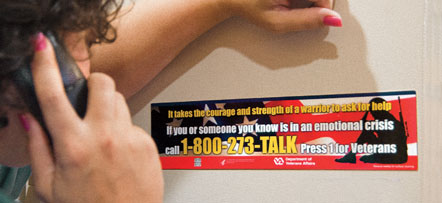
Military Policy Academy Promotes, Plans for Behavioral Health
By Meredith Hogan Pond
For many returning service members, veterans, and their families, a variety of services are needed to ease the adjustment to life away from the battlefield, including substance abuse and mental health services.
To help, SAMHSA convened a Returning Service Members, Veterans, and their Families Policy Academy. For the 2-1/2-day event in early June, SAMHSA’s planning partners included the Department of Veterans Affairs, Department of Defense, National Guard Bureau, National Association of State Mental Health Program Directors, and National Association of State Alcohol and Drug Abuse Directors.
The goal of the Policy Academy—for the nine states and one territory participating—was to facilitate the creation of interagency strategic plans that ensure needed behavioral health services are accessible to the Nation’s service men and women and their families. The Policy Academy was preceded by pre-planning site visits and followed by technical assistance site visits to help states activate their plans.
Providing a forum is key for states to consider how existing policies, resources, and infrastructure influence the responsiveness, effectiveness, and accessibility of services, and to explore ways to improve the system.
Introduced by SAMHSA Administrator Pamela S. Hyde, J.D., HHS Secretary Kathleen Sebelius encouraged collaboration among participants at the Academy’s opening session. “No one agency or state or community can do this work alone,” she said. “To serve our returning service men and women and their families, we need to
do this work together.”
The Secretary mentioned the growing body of research on the impact of deployment and trauma-related stress on military families, particularly children. Although active duty troops and their families are eligible for care from the Department of Defense, a significant number choose not to access those services
due to stigma or fear that treatment for behavioral health issues will harm their military career or that of their spouse.
Led by professional facilitators, 10-member teams from Alabama, Arizona, California, Maine, New Jersey, North Carolina, Ohio, Puerto Rico, Tennessee, and Washington state worked on practical and sustainable strategic action plans to use when they return back home. The process involved developing strategies for increasing access to appropriate care; closing gaps in the system; increasing interagency communication and collaboration; incorporating evidence-based and best practices; and planning for long-term stability.
Intensive discussions helped each state develop and refine its strategic action plan. States shared practices and lessons learned in critical areas, including involving service members, veterans, and their families in the planning process, improving outreach to populations in rural areas, training community providers to improve cultural competence, and enhancing employment opportunities for veterans.
Hands-on assistance included opportunities to confer with national experts in financing issues, suicide prevention, homelessness, trauma-informed mental health treatment, and substance use prevention and treatment. Other topics included peer-to-peer support for military families and veterans, and ways to increase appropriate use of TRICARE and Department of Veterans Affairs health care resources.
“For the vast majority of the time, teams worked with a professional facilitator who helped them work all of this through,” said Eileen Zeller, M.P.H., a public health advisor at SAMHSA’s Center for Mental Health Services, who helped coordinate the Policy Academy. “The facilitation, the intensity, the ability
for many agencies to focus on a single issue, and the availability of national experts to help participants when they got stuck—which everyone took advantage
of—that made the process so successful.”
SAMHSA’s role in this initiative is one of leading by promoting partnerships. For more information on SAMHSA’s efforts, visit the Agency’s Web site.
